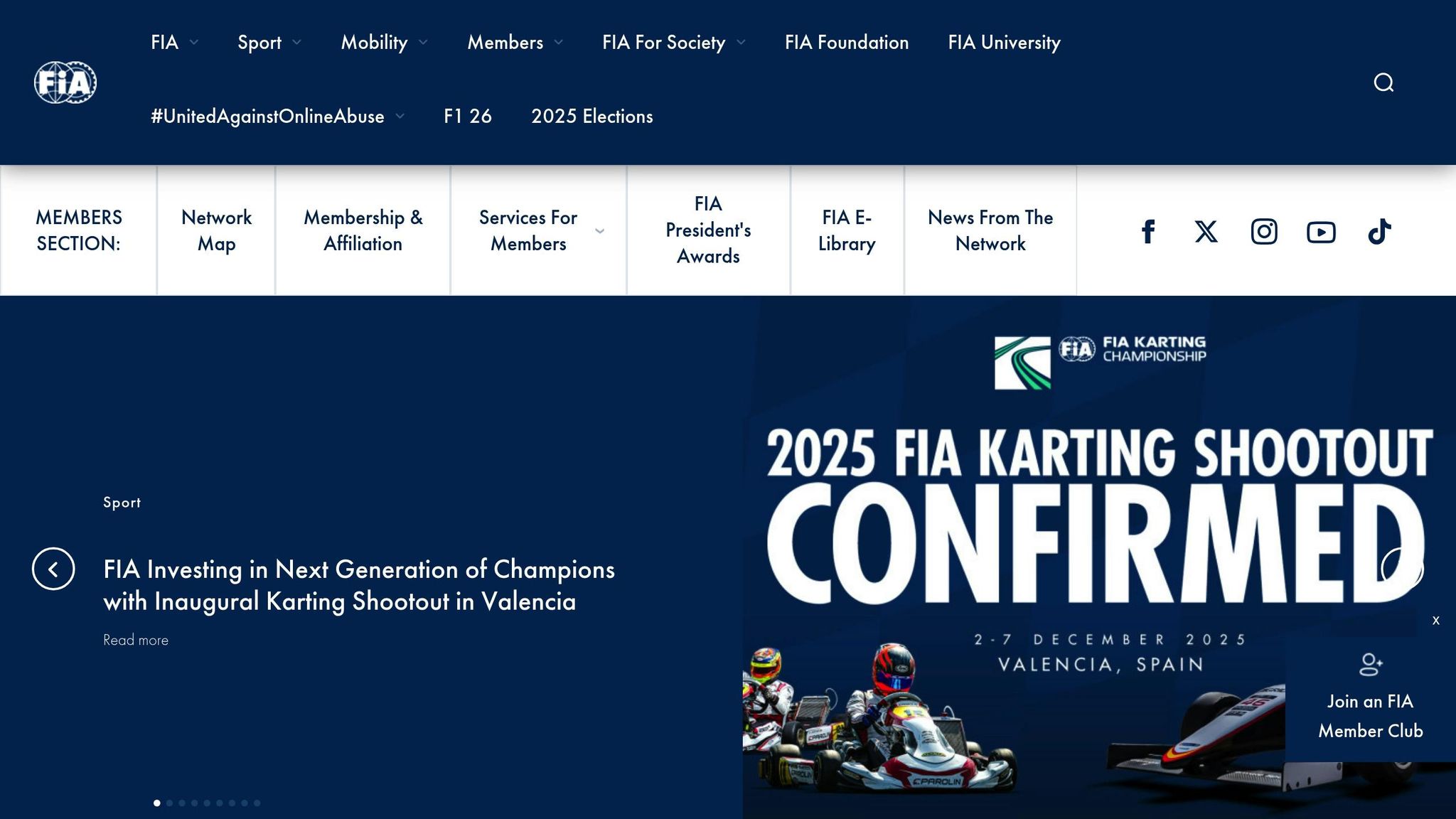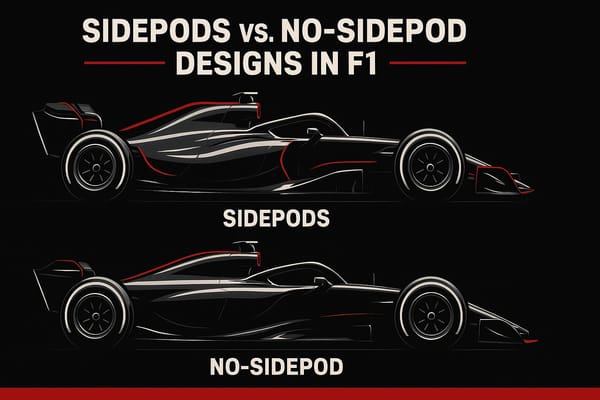Engine Mapping vs. Torque Mapping in F1
Explore the critical roles of engine mapping and torque mapping in optimizing Formula 1 car performance under varying conditions.

Formula 1 cars rely on engine mapping and torque mapping to optimize performance and driver control. These systems adjust how power is generated and delivered, impacting speed, fuel efficiency, and tire management.
- Engine Mapping: Focuses on internal engine settings like fuel-air mixture, ignition timing, and turbo boost to maximize power and efficiency.
- Torque Mapping: Manages how power reaches the wheels, tailoring it to throttle input, grip levels, and track conditions for better control and reduced tire wear.
Key Differences:
- Engine Mapping adjusts the engine's internal behavior for peak performance.
- Torque Mapping ensures smooth and predictable power delivery to the wheels.
Both systems work together to fine-tune performance for different scenarios, like qualifying, races, or wet conditions. While engine mapping generates power, torque mapping ensures drivers can use it effectively. FIA regulations now strictly monitor these systems to maintain fair competition.
F1 engine mapping - Chain Bear explains

Engine Mapping: How It Works and What It Does
Engine mapping is the backbone of Formula 1 power units, fine-tuning every detail to deliver peak performance. This intricate system adjusts key engine parameters to strike the perfect balance between power, efficiency, and control - giving drivers the precision they need to excel at the highest level. Let’s break down how it works.
Engine Mapping Operation
At its core, engine mapping tweaks three crucial elements: the fuel-air mixture, ignition timing, and turbo boost pressure. Together, these adjustments optimize how the engine behaves under different conditions.
- Fuel-Air Mixture: This controls how efficiently the engine burns fuel and helps manage its temperature. For example, in hot climates, engineers might use a richer mixture for better cooling, while leaner mixtures improve fuel efficiency during longer stints on track. This flexibility is key to managing performance and thermal stress during demanding races.
- Ignition Timing: This dictates when the spark plugs fire in relation to the piston's position, directly influencing power delivery and throttle response. Properly timed ignition enhances acceleration out of corners, giving drivers the edge during overtakes or defensive moves. However, it’s a delicate balance - too aggressive, and the engine risks overheating or knocking.
- Turbo Boost Pressure: By fine-tuning boost levels across RPM ranges, teams can ramp up power at higher speeds while ensuring smooth performance at lower ones. This creates a power curve tailored to the demands of each track.
David Lamb, an engine engineer at Renault Sport F1, explains that engine mapping ensures consistent drivability across varying tracks and weather conditions. He emphasizes that without precise mapping, maintaining predictable engine behavior would be nearly impossible.
Modern F1 engine maps are essentially two-dimensional tables that match engine speed with throttle position to determine the best torque output for any given moment. Engineers can create multiple maps, each tailored to specific race scenarios, ensuring the car performs at its best no matter the conditions.
Race Scenario Applications
Engine mapping isn’t a one-size-fits-all solution; it evolves depending on the race situation. Teams develop specialized maps for different phases of a race weekend, aligning with their strategic goals.
- Qualifying Maps: These maps are all about raw power. Engineers push the engine to its limits with aggressive ignition timing and higher turbo boost for short bursts of maximum performance during qualifying laps. It’s a high-risk, high-reward setup designed to extract every ounce of horsepower.
- Race Maps: During races, the focus shifts to fuel efficiency and engine durability. These maps often limit power output in certain RPM ranges or adjust fuel flow to go the distance without compromising lap times. This approach becomes especially critical in fuel-limited races where strategy can make or break a result.
- Wet Weather Maps: When the track is slippery, smooth power delivery is crucial. Wet weather maps adjust throttle response to reduce wheel spin, giving drivers better control and traction in challenging conditions.
The introduction of hybrid power units adds another layer of complexity. Engine mapping must seamlessly integrate the internal combustion engine with the MGU-K’s electrical energy. This coordination ensures smooth power delivery, especially during acceleration when both systems work together.
Real-time telemetry plays a vital role in engine mapping. On-car sensors continuously feed data back to the team, allowing engineers to compare the engine's performance to the reference map. If discrepancies arise, adjustments can be made throughout the weekend to keep the engine running as expected.
This level of precision also supports advanced systems like torque mapping, which further enhances the car’s performance on track.
Torque Mapping: How It Works and What It Does
Torque mapping goes beyond basic engine management by fine-tuning how power is delivered to the wheels. Think of it as the bridge between the driver's inputs and the engine's response, ensuring precise control over the car's behavior. This system plays a pivotal role in tailoring the car’s performance to specific conditions and driver preferences.
How Torque Mapping Operates
At its heart, torque mapping relies on interconnected maps within the ECU (Engine Control Unit). Three main components form the backbone of this system: the engine torque map, the driver demand torque map, and the pedal map.
- Engine Torque Map: This is a two-dimensional table that uses engine speed and throttle position to define how power is delivered.
- Driver Demand Torque Map: It translates the driver’s desired torque output based on engine speed and normalized torque values.
- Pedal Map: This converts the pedal position into a normalized torque signal, bridging the gap between driver input and engine response.
These layers work together, allowing engineers to fine-tune the car’s behavior in real-time. By monitoring sensor data, they ensure the actual torque output matches the reference maps. Any mismatch can signal issues that need immediate attention, such as drivability concerns.
One of the standout features of torque mapping is its ability to cater to individual driving styles. Teams can create custom throttle response profiles to suit specific needs, like improving corner exits or adjusting for wet-weather handling. Even environmental factors, such as low air density, are accounted for by calibrating the torque map to maintain a consistent feel and predictable performance.
This meticulous calibration doesn’t just enhance performance - it plays a crucial role in tire management, directly influencing race outcomes.
Impact on Performance and Tire Management
In Formula 1, where traction control is absent, torque mapping becomes an essential tool for optimizing tire performance. By controlling how torque is delivered - especially during corner exits - it helps prevent wheelspin and reduces tire wear. For instance, at 50% throttle and 15,000 RPM, an F1 engine might produce around 200 Nm of torque. If wheelspin causes the RPM to spike to 16,000, torque mapping can automatically reduce the output, preserving tire grip.
During a race, teams often tweak the torque map to adapt to changing conditions. If tire wear becomes a concern, they may switch to a softer map, trading some speed for better traction and longer tire life. In wet conditions, specialized maps smooth out power delivery, minimizing the risk of wheelspin and improving stability.
Advanced techniques like negative slope torque maps are also employed. In lower gears, torque is intentionally reduced as RPM increases, helping manage traction during critical moments like corner exits. In contrast, higher gears use standard maps to maximize acceleration.
The complexity increases further with modern hybrid power units. These systems require seamless coordination between the internal combustion engine and electric motor, ensuring smooth transitions and efficient energy deployment during acceleration phases.
David Lamb from Renault Sport F1 highlights the importance of precision in torque mapping, stating, “Any mismatch between predicted and actual torque delivery can create significant drivability challenges”.
Looking ahead, the integration of machine learning and predictive analytics is pushing torque mapping to new heights. By anticipating changes in grip and adjusting torque delivery proactively, teams are leveraging cutting-edge technology to stay ahead in the ultra-competitive world of Formula 1.
Engine Mapping vs. Torque Mapping: Direct Comparison
Engine mapping fine-tunes the engine's internal performance, while torque mapping manages how power is delivered to the wheels. This comparison builds on our earlier insights into these systems' individual roles, showing why blending their capabilities is so crucial in Formula 1.
Main Differences Between Engine and Torque Mapping
Engine mapping primarily focuses on maximizing the engine's internal efficiency, adjusting parameters like fuel injection timing, ignition, and air-fuel ratios. These adjustments ensure the engine operates at peak performance across various RPM ranges, responding dynamically to engine speed and load conditions.
Torque mapping, by contrast, is all about controlling how power reaches the wheels. It translates the driver's throttle input into precise torque delivery, factoring in variables like tire grip, track conditions, and driving style. This system ensures that the available power is applied effectively, especially in scenarios where traction is critical, such as corner exits.
While engine mapping continuously refines combustion processes, torque mapping activates in specific situations, tailoring power delivery to match real-world conditions.
| Aspect | Engine Mapping | Torque Mapping |
|---|---|---|
| Primary Focus | Internal engine performance | Power delivery to the wheels |
| Main Inputs | Engine sensors, RPM, throttle data | Driver inputs, track and tire data |
| Response Time | Milliseconds (instantaneous) | Real-time |
| Key Outputs | Fuel flow, ignition, boost control | Torque delivery curves, traction aid |
| Performance Impact | Raw power generation | Usable power and tire management |
Pros and Cons of Each System
Each system has its own strengths and challenges, which play distinct roles in race strategy.
Engine mapping is a standout in qualifying sessions, where squeezing out every last bit of horsepower is critical. Teams can push the engine to its limits with aggressive fuel and ignition settings. However, raw power alone isn't enough - if the tires can't handle the output, excessive wheelspin can waste that energy.
Torque mapping, on the other hand, excels during race conditions. By managing how power is applied, it helps maintain consistent lap times and protects tire health. This becomes especially important in wet conditions, where smooth power delivery can prevent loss of control. The system also plays a vital role in managing hybrid power units, ensuring seamless transitions between the internal combustion engine and the electric motor during acceleration.
However, torque mapping's complexity introduces its own risks. With multiple interconnected systems and real-time calculations, calibration errors or unexpected interactions can occur. Teams must invest significant time in simulations and practice sessions to perfect these maps for each circuit's unique demands.
For teams, the choice between prioritizing engine mapping or torque mapping often depends on their goals. Those chasing pole position may favor aggressive engine settings, even at the cost of reliability. Conversely, teams focusing on championship points will lean toward torque mapping strategies that emphasize consistency, tire preservation, and adaptability to changing conditions.
Ultimately, the most effective approach in modern F1 combines the best of both systems. By leveraging engine mapping's power generation and torque mapping's precision, teams can craft strategies that maximize performance while minimizing weaknesses. This synergy is at the heart of competitive F1 power unit technology.
How Engine and Torque Mapping Work Together
Engine and torque mapping work as a cohesive system within the PCU (Power Control Unit), turning throttle inputs into precise performance outputs.
Engine and Torque Mapping Interaction
When a driver presses the throttle, the PCU kicks off a detailed process that connects both mapping systems. First, the pedal map translates the driver’s input into a normalized torque demand, which is then adjusted based on engine speed and current operating conditions.
The engine torque map acts as a guide, linking engine speed and throttle position to the expected torque output. The PCU constantly compares actual torque to this reference, making real-time adjustments to fuel injection, ignition timing, and boost levels.
This coordination becomes especially important in complex situations, like cylinder deactivation and reactivation. A notable example comes from the 2012 F1 season when Renault Sport F1 engineers, led by David Lamb, showcased how their torque map managed fuel and throttle adjustments during these transitions.
In scenarios like wheelspin, negative slope torque mapping plays a vital role. It automatically reduces power to regain traction, ensuring stability and control.
This seamless integration is critical during high-pressure race moments where precision is everything.
Practical Examples and Race Scenarios
One of the most practical applications of this coordination is during tire degradation. As grip diminishes, teams can adjust torque mapping to deliver power more gradually, reducing wheelspin and potentially extending tire life by as much as 15%. At the same time, engine mapping fine-tunes the fuel mixture and ignition timing to ensure smoother power delivery.
The introduction of hybrid power units has added another layer of complexity. The PCU now oversees not just the internal combustion engine but also energy recovery systems (ERS).
David Lamb of Renault Sport F1 highlights that managing this complexity demands advanced algorithms and real-time data processing to ensure smooth transitions between power sources, improving both lap times and reliability.
By aligning engine and torque maps, teams can maintain consistent performance while optimizing tire wear - an essential factor in competitive racing.
Engineers monitor the actual engine torque against the reference map in real time to quickly identify and resolve any drivability issues. This data-driven approach allows teams to fine-tune both systems during practice sessions, tailoring the maps to each driver’s preferences while maximizing traction and overall performance.
The sophistication of these systems has reached a point where FIA regulations now require teams to justify and seek approval for torque map changes. This ensures fair competition while still leaving room for technical advancements.
Rules and Technical Changes in Mapping Strategies
The FIA has tightened its grip on engine and torque mapping regulations, turning what was once a flexible area of development into a strictly controlled aspect of Formula 1.
FIA Rules Impact on Mapping Systems

In the last ten years, the FIA has gone from having minimal oversight of mapping systems to enforcing comprehensive regulations. Teams can no longer adjust torque maps on a whim to suit specific circuits or strategies - they now need explicit approval from the FIA. For example, the FIA cracked down on "off-throttle blown diffusers", which used engine maps to keep exhaust flow steady for aerodynamic benefits even when the driver wasn’t on the throttle. At high-altitude circuits, like the Mexican Grand Prix, teams must formally request mapping adjustments to adapt to the unique conditions.
This regulatory tightening extends to race weekends, where teams must thoroughly document and justify any changes to engine or torque maps. The FIA’s scrutineering process ensures that all adjustments fall within approved limits, blocking any extreme modifications that could jeopardize safety or reliability.
These rules have significantly influenced how teams approach mapping strategies, setting the stage for the intricate systems discussed in later sections.
Hybrid Power Unit and Mapping Technology Progress
The introduction of hybrid power units in 2014 added a new layer of complexity to mapping strategies. Modern F1 cars now rely on highly advanced engine control units (ECUs) to manage the interplay between the internal combustion engine, electric motor deployment, energy recovery, and turbocharger performance. This innovation has dramatically expanded the scope of mapping, requiring teams to coordinate variables like fuel injection, ignition timing, electric power delivery, and energy harvesting. These systems enable engineers to fine-tune torque delivery for maximum acceleration while optimizing energy recovery during braking, directly impacting race strategy and lap times.
Take high-altitude races as an example. At venues like the Mexican Grand Prix, where reduced air density affects engine output, teams might request adjustments to torque maps to ensure consistent throttle response. At the same time, they optimize hybrid system deployment to compensate for the drop in internal combustion engine performance. Such changes must be pre-approved by the FIA and programmed into the car's ECU well in advance of race day.
Looking to the future, the planned removal of the MGU-H (Motor Generator Unit – Heat) in 2026 is expected to simplify hybrid systems. This change will force teams to rethink their mapping strategies, creating new challenges for balancing hybrid components with the internal combustion engine.
Evolution of Mapping Strategies: A Comparative Overview
The evolution of mapping strategies reflects the combined impact of regulatory changes and technological advancements.
| Era/Regulation | Mapping Flexibility | FIA Oversight | Technical Focus |
|---|---|---|---|
| Pre-2008 (No SECU) | High | Low | Performance, traction control |
| 2008–2013 (SECU) | Moderate | Increased | Fairness, anti-cheat measures |
| 2014+ (Hybrid Era) | Limited | High | Hybrid integration, energy efficiency |
Note: The 2026 regulatory changes, particularly the removal of the MGU-H, are expected to simplify hybrid systems, though the full implications remain to be seen.
Teams that excel in integrating mapping strategies gain a clear edge, with better fuel efficiency, improved tire management, and stronger race performance. The ability to balance internal combustion engine output with electric power - while staying within strict FIA regulations - has become a cornerstone of success in modern Formula 1.
Conclusion: Main Points on Engine and Torque Mapping
Engine and torque mapping are at the heart of Formula 1 performance, translating split-second engineering decisions into tangible on-track advantages. These systems work in harmony to push the power unit to its limits while adapting to the ever-changing demands of modern racing. This intricate balance showcases the technical precision discussed throughout this article.
Why Mapping Systems Matter in F1
Mapping systems are crucial because they allow teams to fine-tune engine and torque delivery for different track layouts, weather conditions, and race strategies. By adjusting these maps, teams can ensure consistent throttle response and adaptability, no matter the scenario. This adaptability not only boosts performance but also helps manage fuel efficiency and tire wear - key elements for a successful race.
One clear example of their importance is how teams use distinct maps for qualifying and race conditions. Qualifying maps are designed to extract maximum power, while race maps focus on conserving fuel and protecting tires for long-term performance.
Renault Sport F1 engineer David Lamb explains that torque mapping serves as a reference point to ensure the engine performs as expected on track, with any deviations signaling potential drivability issues.
Final Thoughts
These insights highlight how mapping systems represent the perfect blend of engineering precision and strategic thinking in Formula 1. Engineers craft maps tailored to each driver, track, and race scenario, while strategists determine the best moments to deploy specific maps for optimal results.
With the driver demand torque map, for instance, a driver can experience what feels like a completely different engine without any physical modifications. In some cases, maps can even shift automatically based on the car's position or gear, ensuring peak performance throughout a lap. However, innovation in mapping is tightly controlled, as FIA regulations now require teams to justify and gain approval for major mapping changes.
Ultimately, understanding these systems reveals the delicate interplay of raw power, precision control, and strategic execution that makes Formula 1 so extraordinary. Every throttle adjustment and tactical decision relies on these systems working seamlessly to deliver the breathtaking performance fans witness on race day.
FAQs
What’s the difference between engine mapping and torque mapping, and how do they work together to optimize a Formula 1 car’s performance?
Engine mapping and torque mapping are key technologies in Formula 1, tailored to get the most out of a car in different race conditions. Engine mapping adjusts critical settings like fuel delivery and ignition timing to strike a balance between power, efficiency, and reliability. Meanwhile, torque mapping focuses on fine-tuning how the engine's power reaches the wheels, giving drivers precise control over acceleration and traction.
These systems work together seamlessly to adapt the car's performance to specific situations, such as wet tracks, long high-speed straights, or sharp corners. For example, in rainy conditions, torque mapping can reduce wheel spin by carefully managing power delivery, while engine mapping ensures the engine runs efficiently without being overworked. This combination gives drivers the control they need to push the car to its limits while maintaining steady performance throughout the race.
How do FIA regulations influence the use of engine and torque mapping in F1 cars?
In Formula One, FIA regulations are pivotal in determining how teams can develop and use engine and torque mapping strategies. These rules are crafted to promote fair play, prevent extreme performance disparities, and uphold safety on the track.
For example, the FIA prohibits specific mapping configurations that could mimic traction control, which would give teams an unfair edge. Additionally, there are strict guidelines on how engine modes can be utilized during both qualifying sessions and races. This ensures teams strike a balance between peak performance and engine reliability. These restrictions challenge engineers to think creatively while staying within the defined limits, making regulatory compliance a critical aspect of F1 strategy.
How do hybrid power units add complexity to engine and torque mapping in modern Formula 1 cars?
Hybrid power units have brought a whole new level of complexity to engine and torque mapping in Formula 1. These cutting-edge systems pair traditional internal combustion engines with advanced energy recovery systems (ERS), which capture and reuse energy from braking and exhaust heat. This means engineers now have to juggle fuel efficiency with smart energy deployment to squeeze out every bit of performance.
Engine mapping involves fine-tuning fuel delivery and ignition timing to match specific track conditions. On the other hand, torque mapping ensures that power reaches the wheels smoothly, especially when factoring in the extra torque provided by the ERS. Together, these two systems must work in harmony to strike the perfect balance between power, efficiency, and control - making them a cornerstone of F1's technical game plan.




